The House Edge
Curated by Caitlin Chaisson,
2023 Curatorial Open Call Recipient
September 28, 2023 – January 13, 2024
Virtual presentation at bottom of page
Jim Denomie, The Posse, 1995. Oil on canvas, 36x48 in. Courtesy of the artist’s estate and Bockley Gallery.
The Shelley & Donald Rubin Foundation is pleased to present The House Edge, curated by Caitlin Chaisson. The exhibition features the work of sixteen artists who consider the economic dimensions of Indigenous sovereignty. Though capitalism seeks to define relations between subjects and places, the artists demonstrate how notions of land ownership, property, and consumerism are contested and rewritten through diverse Indigenous practices. Showcasing drawing, painting, print, sculpture, video, and photography, with many works exhibited publicly for the first time, The House Edge will take place at The 8th Floor and run from September 28, 2023 through January 13, 2024.
Featured artists include David Bradley, Jim Denomie, Joe Feddersen, Harry Fonseca, G. Peter Jemison, Chaz John, Matthew Kirk, Terran Last Gun, Rachel Martin, Kimowan Metchewais, Nora Naranjo-Morse, Duane Slick, Jaune Quick-to-See Smith, Bently Spang, Hulleah J. Tsinhnahjinnie, and Nico Williams.
The ‘house’ addressed in the show’s title suggests multiple meanings: a place of belonging, a site of governmental assembly, and a reference to gambling, where the house is colloquially understood as the dealer or the casino. Since the first signing of treaties with the United States, Native American nations have defended their preexisting rights to govern the activities happening on their lands. In the 1970s, this self-determination was tested in the courts by a case involving high-stakes bingo operations, and a legal precedent was set. Congress eventually passed the federal Indian Gaming Regulatory Act (IGRA) in 1988, a jurisdictional framework to oversee what is now a multibillion-dollar industry.
The act has had immense material and symbolic effects. For nations that have pursued gaming (and less than half of federally recognized nations have), the wealth generated by casinos has been used for essential housing, education, medical, and infrastructural services, offsetting generations of hostile underfunding and deferrals of promised aid from the US government. Profits are further directed towards art and culture, including support for language revitalization and enabling governments to buy land back; however, IGRA has shifted the jurisdictions of state and federal powers, with Native American nations required to form state compacts to operate gaming enterprises. The fact that capitalist values of individual accumulation are incompatible with many Indigenous economies founded on principles of reciprocity and interdependence has also presented a divisive challenge.
The multidisciplinary artworks presented in The House Edge facilitate important dialogues about wealth, power, culture, and the role of contemporary art in mediating value. Please find a full press release linked below.
Brochure (plain text essay here)
David Bradley (Minnesota Chippewa Tribe) has received numerous awards and fellowships, including the Southwestern Association of Indian Art Fellowship in 1980 and the Minnesota Chippewa Art Award for Merit in Art in 1979. A major retrospective, Indian Country: The Art of David Bradley was organized by the Museum of Indian Arts and Culture/Laboratory of Anthropology in 2019. He has exhibited his work throughout the nation, including at the Plains Indian Museum in Wyoming, the Heard Museum in Phoenix, Plains Art Museum in Fargo, the New Mexico Museum of Art in Santa Fe, the Autry Museum in Los Angeles, the Smithsonian Institute in Washington DC, and many others. His work is in the permanent collections of various museums throughout the United States.
Jim Denomie (b. 1955; d. 2022; Lac Courte Oreilles Band) was a prolific artist, creating vividly hued paintings, works on paper, and sculptures that aimed a critical lens on the history of Indigenous people and their intersections with mainstream culture. A posthumous survey exhibition The Lyrical Artwork of Jim Denomie opened at the Minneapolis Institute of Art in 2023. Selected solo exhibitions of his work include Challenging the Narrative at Michigan’s Muskegon Museum of Art (2020–2021); Standing Rock Paintings at Bockley Gallery (2019), Minneapolis; and Jim Denomie: Paintings at Projek Traumon (2015), Friedrichshafen, Germany.
Joe Feddersen (Colville Confederated Tribes) lives and works in Omak, Washington. He is a celebrated printmaker, glass artist, and basket weaver known for uniting urban imagery and Indigenous design through simple geometric “glyphs” that poignantly reflect on people’s relationship with the environment. Feddersen is a professor emeritus at the Evergreen State College in Olympia, Washington, where he taught from 1989 until his retirement in 2009. In 2024 the Museum of Art and Culture in Spokane, Washington will present a major retrospective of the artist’s work. Feddersen’s work is held in numerous collections including the Seattle Art Museum; The Jordan Schnitzer Museum of Art, Eugene, Oregon; Portland Art Museum, Oregon; Whitney Museum of American Art, New York; Heard Museum, Phoenix, Arizona; and Peabody Essex Museum, Salem, Massachusetts.
Harry Fonseca (b. 1946; d. 2006; Shingle Springs Band of Miwok Indians) was an instrumental force in reshaping Native art with his trademark blend of traditional imagery, contemporary experience, and vibrant color and form. As he used his art to explore both his personal journey and the role of history in shaping Native consciousness in the present, Fonseca sought to expand definitions of Indian art and to shatter the expectations and stereotypes that had long confined it. Fonseca’s best-known work remains his Coyote series, in which the character of Native legend became a vibrant and dynamic avatar for the artist, venturing “off-res” to explore the urban environments. Fonseca’s Coyote was a slippery and adaptable character who spoke to the contradictory expectations placed on Native peoples.
G. Peter Jemison’s (Seneca Nation, Heron Clan) is an artist, curator, historian, and educator. A pivotal figure in the New York City art world, especially its communities of Native artists, Jemison served as the inaugural curator of the American Indian Community House Gallery from 1978 to 1985. His interdisciplinary practice merges the texture of everyday experience and the long sweep of history. Jemison’s works are included in significant collections: The Modern Museum of Art, New York; The Whitney Museum of American Art, New York; The Heard Museum, Phoenix; The Institute of American Indian Arts Museum, Santa Fe; The Denver Art Museum; The British Museum, London; and the Museum der Weltkultern, Frankfurt.
Chaz John (Winnebago Tribe of Nebraska; Mississippi Band Choctaw) is a multidisciplinary Indigenous artist living and working in Santa Fe. He grew up in Topeka, Kansas, received his bachelor’s degree from the Institute of American Indian Arts in 2019, and briefly attended the MFA program before leaving school to pursue tattooing and art full-time. He’s currently developing a new body of work tied to collective dreaming, tattoo imagery, and the parallels of history and tribal stories.
Matthew Kirk’s (Navajo Nation) practice combines the materiality of his long-held job as an art-handler with mark-making inspired by comics, abstraction, and Diné (Navajo) visuality. A 2019 Eiteljorg Fellow, his work was recently featured in The New York Times. His recent solo exhibition White Snake (2023) was presented at Halsey McKay Gallery in New York City. Kirk was born in Arizona, raised in Wisconsin, and is based in Queens, New York.
Terran Last Gun/Saakwaynaamah’kaa (Piikani) centers his work around the process of color exploration and visual documentation of nature, cosmos, cultural narratives, and recollections of home. Last Gun received his BFA in museum studies and AFA in studio arts from the Institute of American Indian Arts (IAIA) in 2016. At IAIA he was a student of Neal Ambrose-Smith. He has received awards from the First Peoples Fund, 2020 Artist in Business Leadership Fellowship, and the Santa Fe Art Institute 2018 Story Maps Fellowship. In 2022, Last Gun was named one of the “Twelve New Mexico Artists to Know Now in the Southwest.” His first museum solo exhibition Terran Last Gun: Future Cosmic Energy opened in 2023 at the Missoula Art Museum, Montana.
Rachel Martin (Tlingit, Tsaagweidei, Killer Whale Clan, of the Yellow Cedar House [Xaai Hit’] Eagle Moiety) works primarily with drawing, but also painting, sculpture, assemblage, and murals. She focuses on themes of Indigenous sovereignty and tribal identity through images of traditional lifeways, matriarchal figures, landscapes, and creatures with humorous undertones and layered symbolism. Recent exhibitions include Indian Theater: Native Performance, Art, and Self-Determination since 1969 (2023), Hessel Museum of Art, Annandale-on-Hudson, New York; Native Women’s Art: Drawn from the Spirits of Ancestors Within (2023), Sealaska Heritage Institute, Juneau, Alaska. Her work is currently held in the collection of the Anchorage Museum, Alaska; Forge Project, Taghkanic, New York; and the Gochman Family Collection.
Kimowan Metchewais (b. 1963; d. 2011; Cold Lake First Nations) was a multidisciplinary Cree artist who began his artistic career working as an illustrator and editor at the Native newspaper Windspeaker. He later received his Bachelor of Fine Arts at the University of Alberta, Edmonton, Canada, before completing his Master of Fine Arts at the University of New Mexico, Albuquerque. In 1995, Metchewais received the Ellen Battell Stoeckel Fellowship to spend the summer at Yale University, New Haven, Connecticut, and in 1996, a national award from the Canadian Native Arts Foundation. At the time of his death, he was associate professor in the art department at the University of North Carolina at Chapel Hill.
Nora Naranjo-Morse’s (Santa Clara Pueblo) work grapples with the ties to and the conflicts inherent in contemporary Native American art. Known foremost for her work with clay, Naranjo-Morse is an artist whose work spans from pottery and figurines to installation exhibits and large-scale public art. Throughout her wide-ranging practice is a commitment to the earth as an evolving organic whole. Her work can be appreciated at the Heard Museum in Arizona and the Minneapolis Institute of Art in Minnesota. She was selected as the winner of the outdoor sculpture competition by the Smithsonian National Museum of the American Indian where her ever-evolving installation, Always Becoming (2006–), was the first work by a Native American artist to be installed on the National Mall in Washington D.C.
Duane Slick’s (Meskwaki Nation of Iowa; Ho-Chunk Nation of Nebraska) work is informed by oral and visual Native American traditions as well as modernist and postmodernist painting histories. A major career survey of work by the artist, Coyote Makes the Sunset Better (2022), was presented at the Aldrich Museum in Ridgefield, Connecticut. Previously, his work has been shown at Albert Merola Gallery, Provincetown, Massachusetts; University of Northern Iowa, Cedar Falls; Gregory Lind Gallery, San Francisco, CA; and Jan Cicero Gallery, Chicago, Illinois, among others. He has received numerous grants and fellowships, including an Eiteljorg Fellowship for Native American Art, School for Advanced Research Fellowship, Joan Mitchell Foundation Grant, and Rockefeller Foundation Grant. His work is in the collections of The National Museum of the American Indian, Washington, DC; DeCordova Sculpture Garden and Museum, Lincoln, Massachusetts; Milwaukee Art Museum, Wisconsin; and C.N. Gorman Museum, University of California, Davis.
Jaune Quick-to-See Smith (Confederated Salish and Kootenai Nation) is an internationally renowned artist, curator, lecturer, printmaker, professor, and cultural worker who uses humor and satire to examine myths, stereotypes, and paradoxes of Native American life. Her art is philosophically centered in her strong traditional beliefs and political activism. Over the past forty years, Smith has organized and curated over thirty exhibitions of Indigenous art, given hundreds of lectures at universities and museums, and exhibited widely nationally and internationally. A major retrospective of her work opened at the Whitney Museum of American Art in New York in 2023. Smith’s work is in the collections of the Walker Art Center, Minneapolis, Minnesota; Smithsonian American Art Museum, Washington DC; Museum of Modern Art, New York; Brooklyn Museum, New York; Metropolitan Museum of Art, New York; and Whitney Museum of American Art, New York, among many others.
Bently Spang (Tsitsistas/Suhtai Nation) is an independent multidisciplinary artist, educator, writer, curator who works in mixed media sculpture, video, performance, photography, and installation. His work confronts and confounds the persistent, romantic, and inaccurate role crafted for Native people in the false narrative of ‘The West.’ His work is in museum collections in the US and Europe, and he has exhibited at such venues as the Metropolitan Museum of Art, New York; the Brooklyn Museum, New York; National Museum of the American Indian, New York; and Nelson-Atkins Museum, Kansas City, Missouri. He has an MFA in Sculpture from the University of Wisconsin-Madison and a BS in Art and Business from Eastern Montana College (now MSU-Billings). He is a 2018 recipient of the Native Arts and Culture Foundation National Artist Fellowship.
Hulleah J. Tsinhnahjinnie (Diné, Seminole, and Muscogee) was born into the Bear clan of the Taskigi, the Tsi’naajinii (Black-streak clan) of the Diné Nation, and a descendent of the Hvteyievlke band of the Seminole Nation of Oklahoma. She was formally adopted in to the Keet Gooshi Hit (Killer Whale Fin House), and also adopted into the La̱xsgiik (Eagle Clan) of Metlakatla. Tsinhnahjinnie is a Professor of Native American Studies at the University of California Davis and is Director of the C. N. Gorman Museum. She received her B.F.A. from California College of Arts and Crafts in Oakland in 1981 and was a Chancellor’s Fellow at University of California at Irvine during her MFA. Tsinhnahjinnie’s creative and documentary work bears witness to over 30 years—documenting protest and establishing an archive of friends and family.
Nico Williams (Aamjiwnaang First Nation) is a multidisciplinary artist whose practice is centered around sculptural beadwork. A recipient of the prestigious 2021 Claudine and Stephen Bronfman Fellowship in Contemporary Art, his work has been included in Indian Theater: Native Performance, Art, and Self-Determination since 1969 (2023), Hessel Museum of Art, Annandale-on-Hudson, New York; Terms of Use (2023), PHI Foundation, Montréal, Quebec; La machine qui enseignait des airs aux oiseaux (2021), Musée d’art contemporain de Montréal; and he will be part of a focus presentation at The Armory Show in New York in 2023. He is based in Montréal.
Caitlin Chaisson (Canada) is a curator and critic based in New York and holds an MA from the Center for Curatorial Studies, Bard College. She recently worked at the Whitney Museum of American Art on Jaune Quick-to-See Smith: Memory Map (2023) and at The Drawing Center on Drawing in the Continuous Present (2022) and Fernanda Laguna: The Path of the Heart (2022). Previously, she served as the Director and Curator of Far Afield (2016–19), an initiative that supports regionally-connected artistic and curatorial practices. She has also held positions at e-flux (New York City), Emily Carr University of Art and Design (Vancouver), and AKA Artist-Run Centre (Saskatoon). Her writing has appeared in Canadian Art, C Magazine, and frieze magazine, among others.
Image description: A colorful oil painting depicting a casino in a splintered landscape of tall mesas. A person flies on a winged horse and trails money as they are chased. Hands reach up from the bottom depths of the canvas, reaching for the bills.
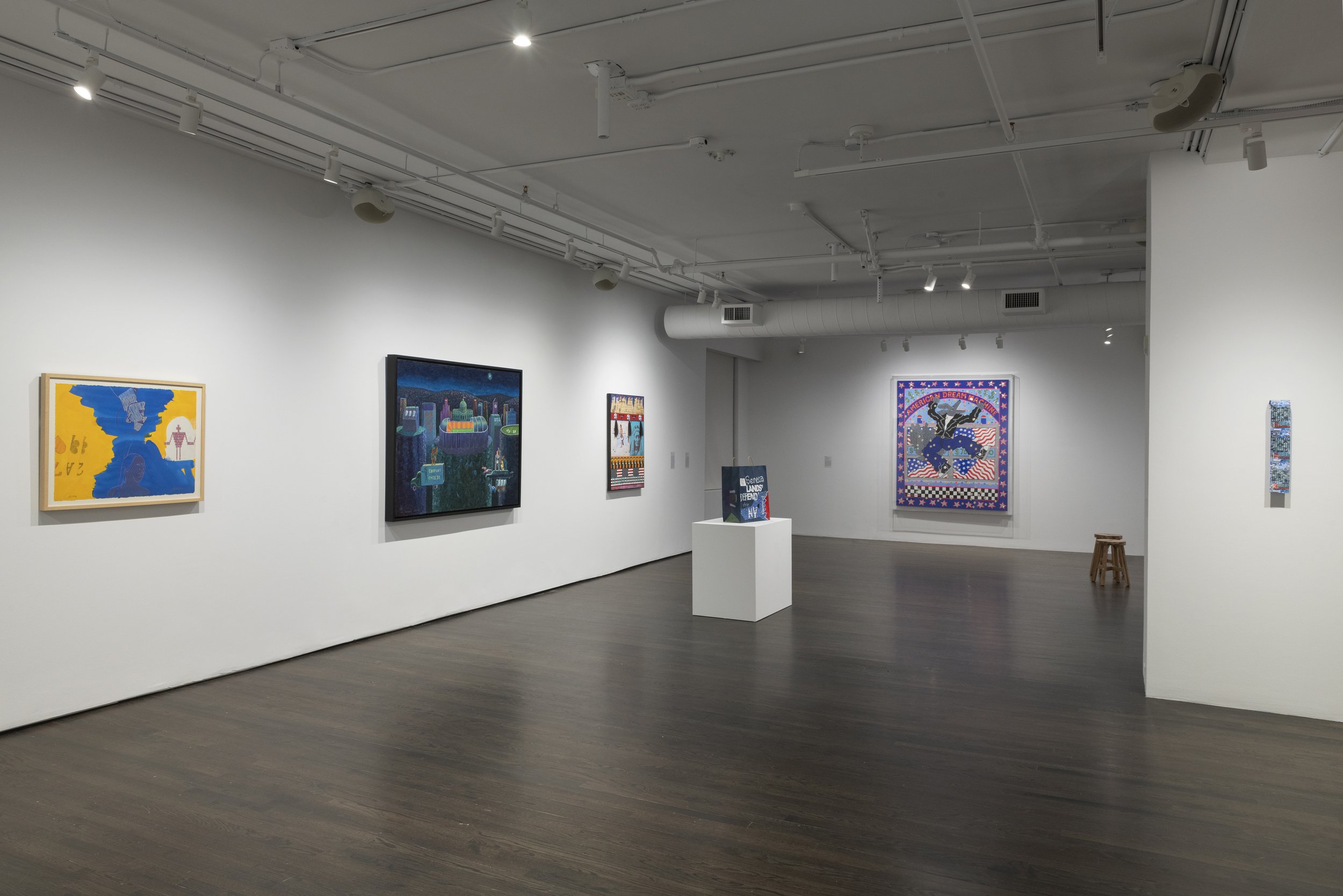
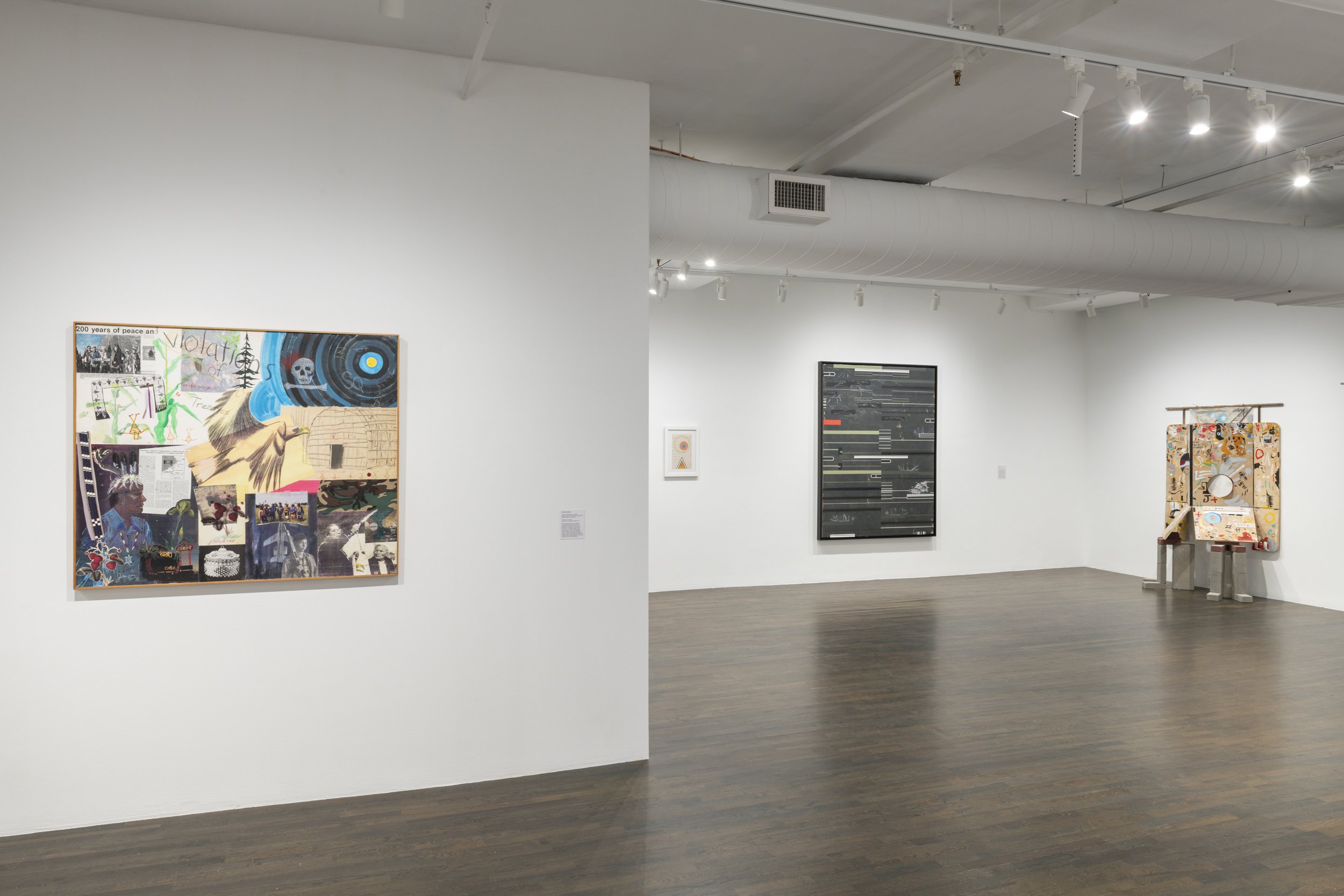
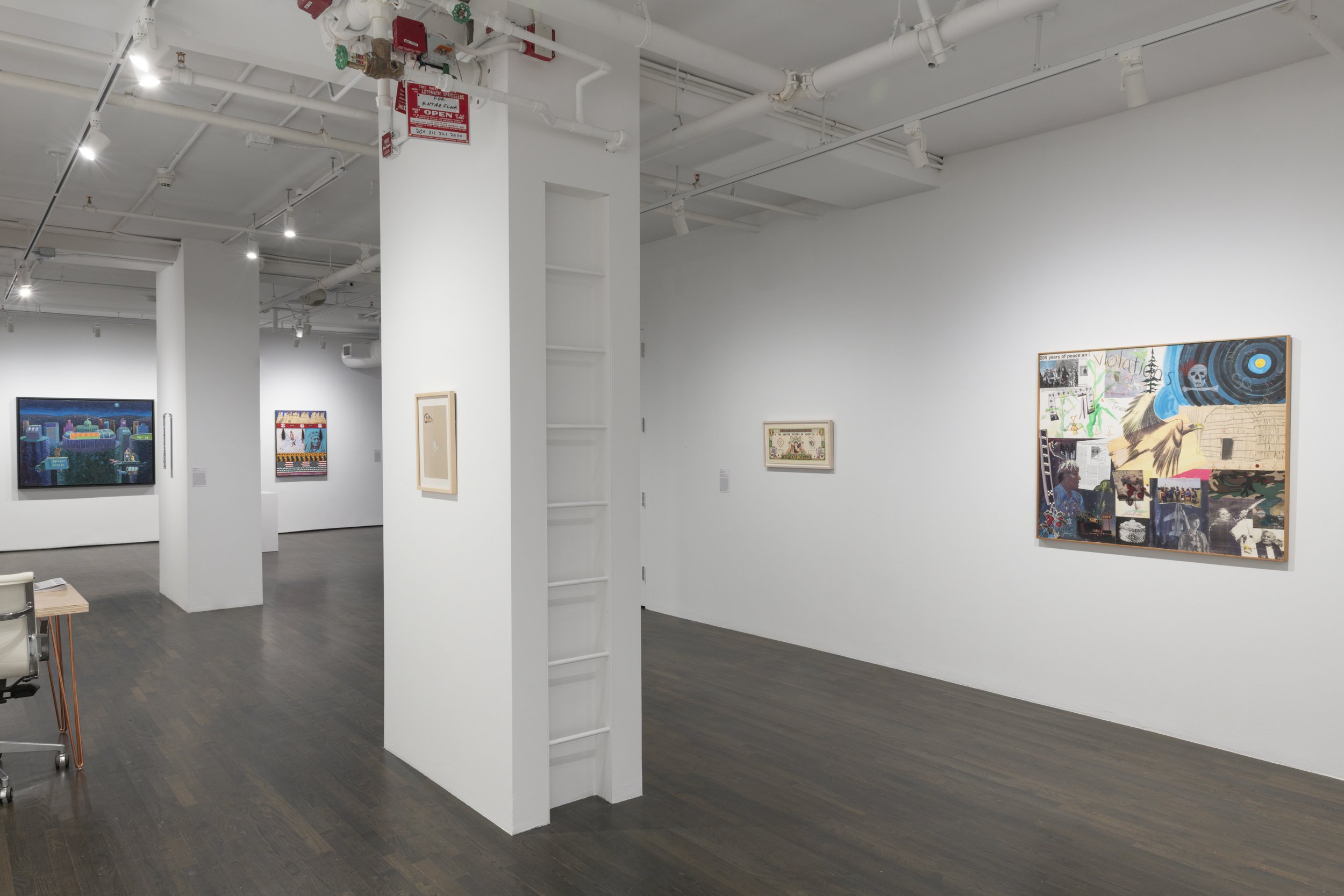
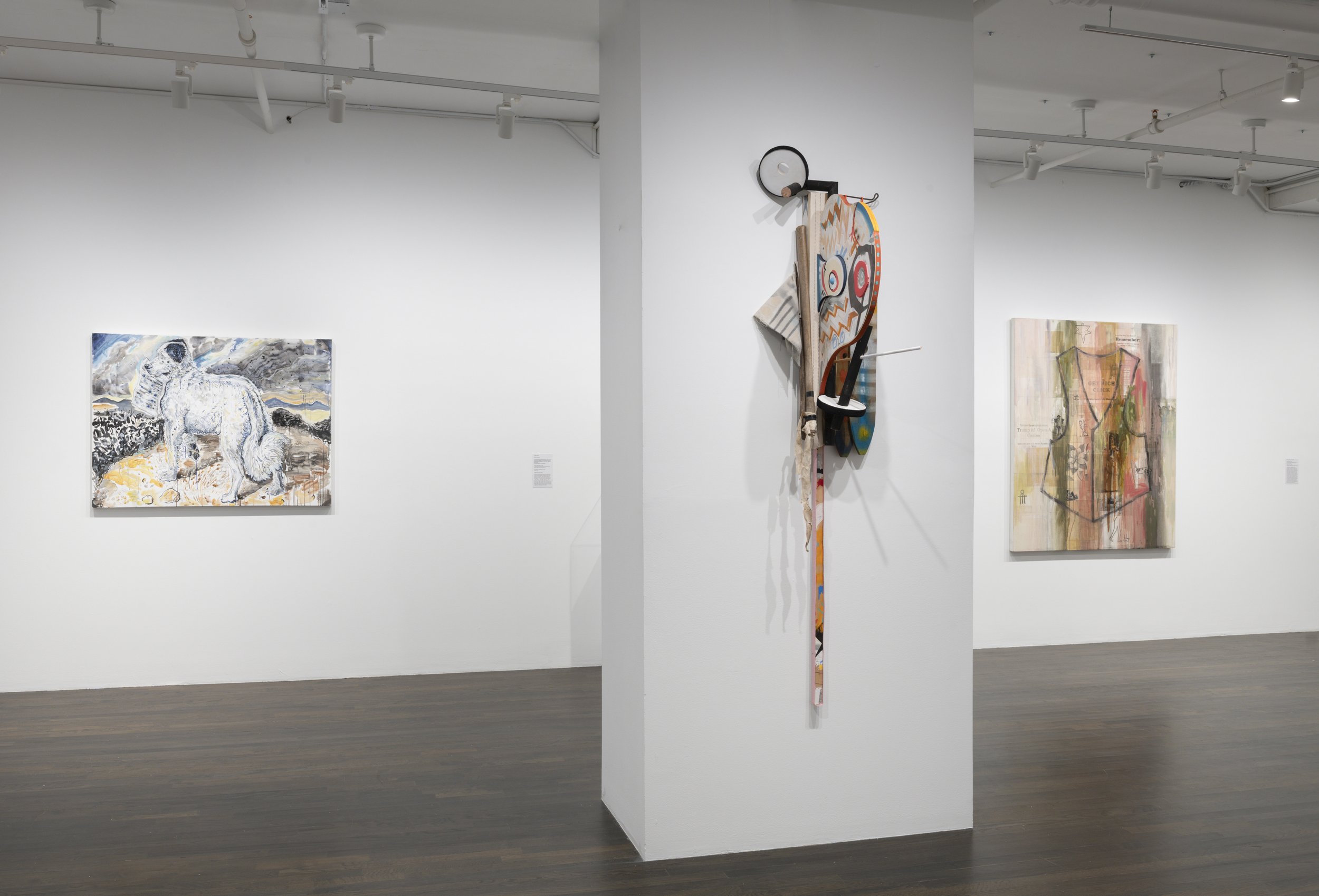

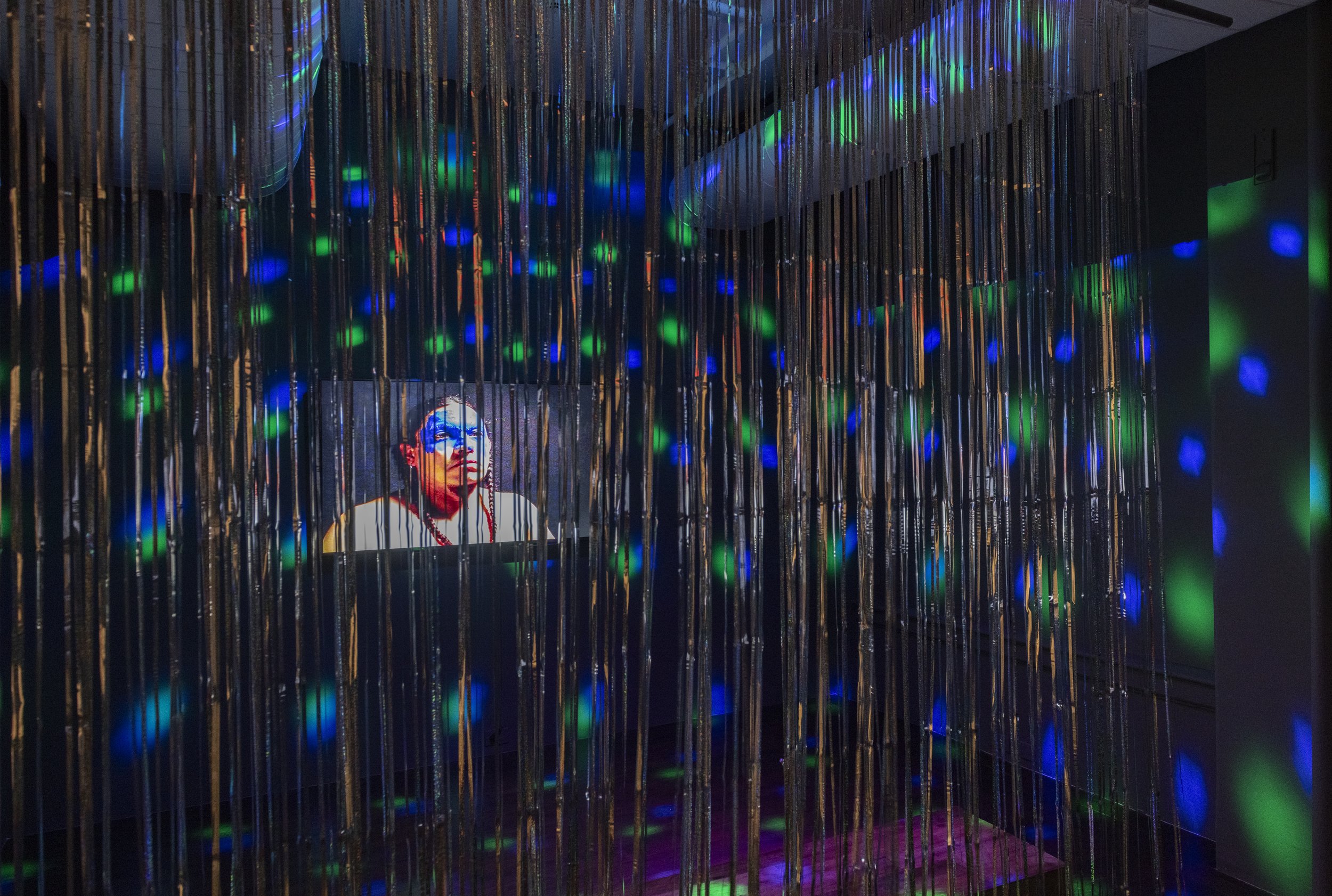
Installation views of “The House Edge” at The 8th Floor, September 2023. Photos by Adam Reich. Courtesy of the Shelley & Donald Rubin Foundation.
Visit the virtual presentation of The House Edge:
Best experienced on desktop. If you encounter any difficulties, please contact info@the8thfloor.org.

